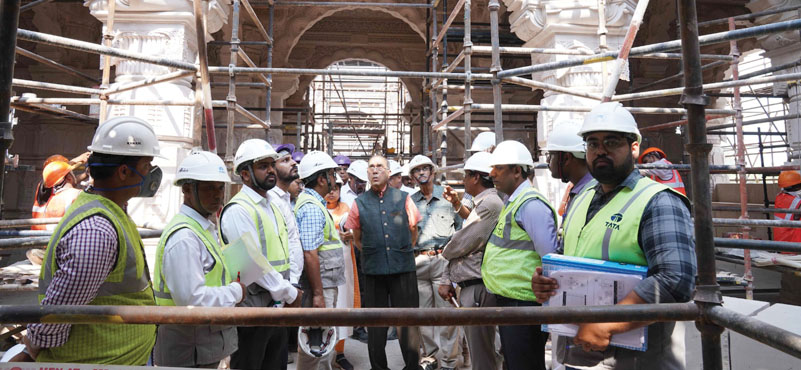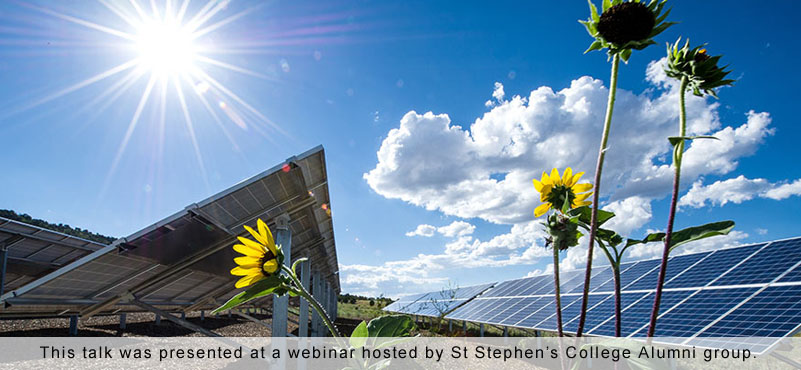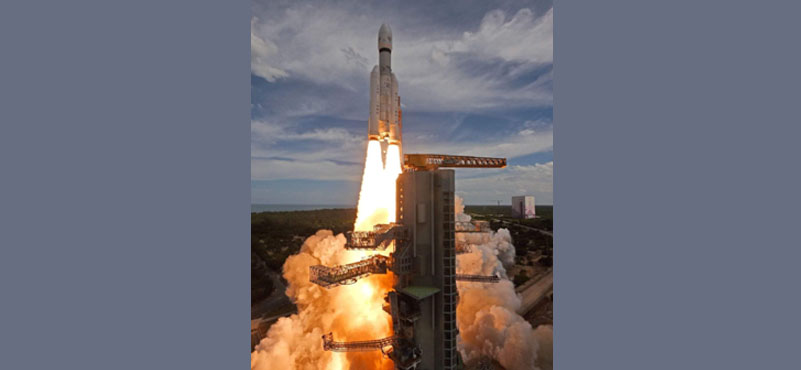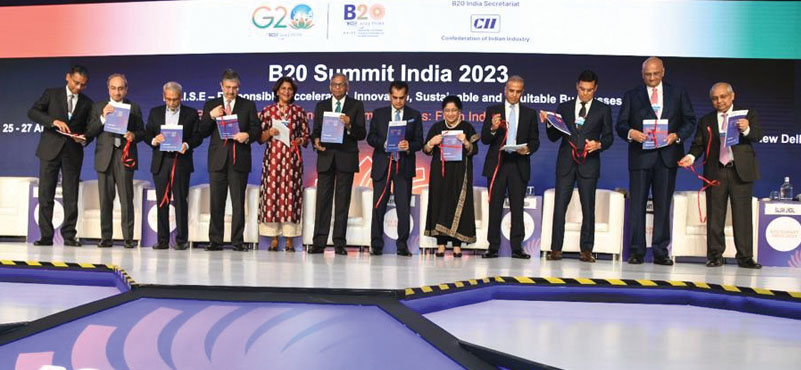DI catches up with Nripendra Misra, Chairman, Ram Janmabhumi Trust, to understand the dynamics of the temple construction, the engineering marvel that will unfold in three phases starting from the end of this year.
DI: The task that is being undertaken is humongous. The size, the proportions and the time lines! If you can share with us the magnitude of the task that you have undertaken. That I think is the central point for many of us.
Nripendra Misra: If you examine the task as qualitative, there are two phases to it. The first phase is a very long history of struggle to restore the deity to its rightful place. That leads to certain emotions, sentiments. And because the struggle itself was less political, more emotional, therefore it has got a greater significance. Now when you see that the judgement of 2019, in the month of November, suddenly an announcement is made that the deity will be installed at the rightful place, which has been the demand. And that there will be another place on which also the interest of other group would be safeguarded. At that moment, a new chapter got opened.
Peace prevailed. There were no winners, there were no losers and it had national acceptability. There was no one who was willing to oppose, no appeal was filed against the judgement. That is the first phase, when you have to imagine the ramifications of this temple. But once the temple was to be built, then it is giving another message. It gives three to four very important messages.
The first message is one of social harmony, which emanates from the life of Ram.
If you see the journey of Ram, 14 years of banishment, then you find that he was meeting various groups of people who were part of this country, but he was able to get their support in his final task to fight evil and to see that the element of evil no longer exists. So that harmony, after all, what is Mariyada…..Mariyada means all the highest values of human life. So here is a person who was passing through as a human being but was finally, while returning from banishment and going back to Ayodhya, who had turned into a God, a godlike figure. At that time, he became God. But before that point in time, he was a Raja, was a godlike figure and a most benevolent king. So, the first message is of harmony.
The second more important message is that social recognition, which is not limited to India, not only to Indian citizens. It was also to people abroad. Everywhere. That something which was a point of conflict, that has resolved into, to not just a resolution, but it has converted into a position where it is now giving a new message. A new message is emanating from that place. So, the entire emotional background of before and after the installation, it changes the mood of the nation from one which was a fight with no hope that it will ever happen. Nobody till 2019 believed that the temple will ever be built. Everybody thought it is just talk. It is a political gimmick. It is nothing but something which is created for raking a controversy at the time of elections and that it is a vote catching device. Suddenly you find that it has become a reality. So, the mood of the nation changed and the nation felt that justice has been done by the installation of God there. After all, earlier also, there was a God there. But that God was in his tent; in a temporary accommodation.
Here is a place where what has been given to him as due. It has to be felt. It is there in the pulse of the nation. It is there in the vibration of the air of the country that a justice has been restored, fair play has been restored. A rightful place has been given to a deity of people who have faith in that and that it will no longer be now a point of conflict between various communities. So that is what I would consider as important for the site.
DI: But, to the task now of building the temple…
Nripendra Misra: Yes, returning, if you are thinking of it, the structure, the construction, the aspirations, the ambitions at the time of construction, when it is started, all these things were not defined. What will be the life of the construction that we undertake? What will be the big features of the construction? What will be the aesthetic sense of the construction? What will be the engineering marvel of this construction? These things were not defined. The only thing known was what is the ambition, emotion, aspiration, of the local area, of the sages and saints of the country and of the masses in general. All these three amalgamated.
DI: So how did all these factors come about then finally?
Nripendra Misra: Well, there were various ways by which these messages were getting absorbed by those who were responsible for the construction. Of course, the team which was there and that team was involved. But let me take just a small example.
Everybody wished that this temple must be a thousand years old. So, we knew that this is the universal requirement. Now we didn’t have any engineering detail. That is the fact that our temples are all over India. They have a life durability. They are seen even today with very little of maintenance. You will agree that the Indian temples last for 800 years and more. But what are the engineering skills required for doing that? That was nowhere recorded. It is the first time that you will have a temple which will have a record not only for the construction, but it will become a record for adopting a new syllabus in the engineering colleges and IITs, that how temple engineering must be followed.
DI: But how did you study that this is a pattern which was a thousand-year-old also?
Nripendra Misra: Well, I suppose this came mostly from firstly the experts. We had five IITs who were advising us. We have Central Building Research Institute. So, they were of course told what was the basic requirement. But then there were stories which are coming from the sages. There were stories which were coming from the saints who had their own view. On one single aspect that I will share with you, how concerns mattered. Initially, we thought of constructing with piles foundation, but there was a very effective intervention I would call it from the representatives, the spiritual figures. Who said that no, we don’t want Piles foundation. We want this soil to be tested. And this soil is not strong enough. We will not mind if this soil is totally removed, dug out, and a new engineered soil is created here, which turns into a stone.
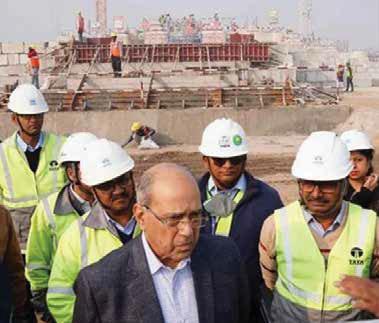 Nripendra Misra has been a high-profile government officer for many decades. Born 8 March 1945, he is a 1967 IAS officer from the Uttar Pradesh cadre who served as Principal Secretary to the Prime Minister of India, Narendra Modi from 2014 to 2019. He earlier served as the chairperson of the Telecom Regulatory Authority of India, Telecom Secretary of India and Fertilizers Secretary of India. He was awarded the most prestigious Padma Bhushan in 2021.
Nripendra Misra has been a high-profile government officer for many decades. Born 8 March 1945, he is a 1967 IAS officer from the Uttar Pradesh cadre who served as Principal Secretary to the Prime Minister of India, Narendra Modi from 2014 to 2019. He earlier served as the chairperson of the Telecom Regulatory Authority of India, Telecom Secretary of India and Fertilizers Secretary of India. He was awarded the most prestigious Padma Bhushan in 2021.
Misra has an MPA in public administration from John F. Kennedy School of Government at Harvard University, a postgraduate degree in chemistry and political science and public administration from the University of Allahabad.
Misra’s international exposure includes being Minister (Economic) in the Indian embassy in Washington, D.C., consultant to the World Bank, the Asian Development Bank, the International Fund for Agricultural Development and the Government of Nepal.
In May 2014, newly elected prime minister, Narendra Modi, appointed him as his principal secretary, through the Appointments Committee of the Cabinet (ACC) and was given the rank and status of Cabinet Minister, the Government of India.
Post his resignation as principal secretary, Mishra was appointed the chairperson of the executive council of the Nehru Memorial Museum and Library in January 2020.
He was elected as the chairman of the temple construction committee of the Shri Ram Janmabhoomi Teerth Kshetra Trust in February 2020.
So, the foundation they wanted made of stone. So instead of soil, they wanted the foundation to be made of stone. So, we had to undertake a fresh engineering survey with another group of experts, very well-known engineers. Some of them were ex-directors of IIT. And they studied and they said that, well the pile foundation was one option, but the other foundation is that you remove the soil and not just one metre or two metres but you remove the soil till 15 metres down. Which is equivalent to a three-story building. You remove that and fill it with the soil, which we as engineers would recommend. The new soil was aggregated. This was made out of small stones, mixed and blended with a very special chemical and cement. And then layers after different layers, 47 layers were laid. One after the other, due compaction was made. And the quality that emerged became that each layer, which was formed after 28 days, had the same quality as stone. Today, if you go and take a sample from there, it will be a stone.
DI: This would make it an Indian engineering marvel?
Nripendra Misra: Oh yes. And recommended by IIT, Madras, Surat and Central Building Research.
DI: So, what else was the challenge? I mean one is foundation? Then when we are actually thinking of the design of the sanctum sanctorum?
Nripendra Misra: You see when we were designing that, then there were considerations of what would will be the height. So, we could sense that the feeling is that it should be minimum at least two to three storey, which should give then prominence of place to the sanctum sanctorum. And above that the Shikhar should be high enough. So that was considered. But while doing that, another challenge came and that challenge was if you make such a heavy structure and if you use the stone. No cement and no steel. Cause the steel has the life of 94 years. So, there are these red stones, Rajasthan’s Bansi Paharpur, which have been joined together with copper. Copper pins have been used to join them together.
But every time the stone height was determined, the load of the stone, how in case of let us say an earthquake, what resilience it will have and how that load factor will disseminate through the plains, through the raft and then through the foundation.
DI: So, this was determined eventually by whom?
Nripendra Misra: All these were jointly discussed. I would say that even this engineering marvel that I call it is a collective effort of everybody. The engineers and the dreamers.
DI: What would be the height now of the full temple?
Nripendra Misra: The full temple from the ground level is 161 feet.
DI: And that of the Ram’s Murti?
Nripendra Misra: Oh, that is different story. Ram Murti is a Ram Lallan Murti. It is not Ram, it is child Ram. We had to determine that because we also wanted that on Ram Navami, the light will fall on the deity. So that has been determined that that will have a height of 51 inches. And that was determined taking into consideration the average height of devotee. Every devotee wants to see his charan and he wants to see the eyes of the god. These are the two things which he worships and takes back the blessings. So, we had to determine, and the average height taken of India was about five feet, eight inches. Which is how we calculated. But then it was modulated because of technology. The technology which was done by the Aeronautic Astronomical Institute in Pune and the Central Building Research. They have done it in a manner that how the sun rays will come, what manner it will get diverted to the temple and then it will penetrate.
DI: The task of putting all these elements together. Did was that assigned to some agency?
Nripendra Misra: You see, I am of course Chairman of the Construction Committee, but I work with my Trust. There is a full Trust which takes interest in the matter. And the task has been given to, first, the construction is tasked to Larsen & Toubro. The project monitoring is to the Tata Consulting Engineers. The stone monitoring is to the National Institute of Mechanics of Stone. So what kind of stone is coming, is monitored there by them and they certify that this is the right stone or not. Then there are 5 IITians with whom we signed contracts for advisory services. So, it is a huge effort.
Navin Berry: So, if I have a concern, that this very sentimental and emotional dream coming true for millions of people in the country. And in three years’ time you’ll be building the temple. There’s no compromise down the line due to speed.
Nripendra Mishra: No. None. We will have a temple the world will be proud of. We would deliver the complete temple in 2024 December. We would deliver the ground floor with the deity installed in sanctum sanctorum in December 2023. And we would deliver the entire complex in 2025. The temple in 2024, the complex of 71 acres in 2025.
So, the work goes on, in God’s own speed. For a people who have their faith with them! With only a few months to go, with a formal opening expected sometime in the new year! All kudos to the team that is working 24×7, 365 days, to fulfil a mission and a dream!
ABOUT THE AUTHOR
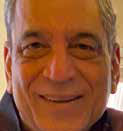 Navin Berry, Editor, Destination India, over five decades has edited publications like CityScan, India Debates and Travel Trends Today. He is the founder of SATTE, India’s first inbound tourism mart, biggest in Asia.
Navin Berry, Editor, Destination India, over five decades has edited publications like CityScan, India Debates and Travel Trends Today. He is the founder of SATTE, India’s first inbound tourism mart, biggest in Asia.

